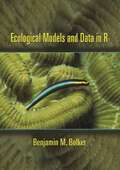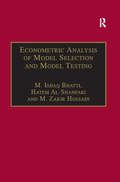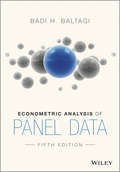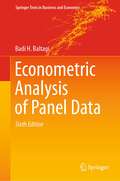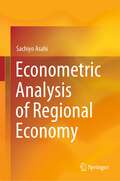- Table View
- List View
Ecological Models and Data in R
by Benjamin M. BolkerEcological Models and Data in R is the first truly practical introduction to modern statistical methods for ecology. In step-by-step detail, the book teaches ecology graduate students and researchers everything they need to know in order to use maximum likelihood, information-theoretic, and Bayesian techniques to analyze their own data using the programming language R. Drawing on extensive experience teaching these techniques to graduate students in ecology, Benjamin Bolker shows how to choose among and construct statistical models for data, estimate their parameters and confidence limits, and interpret the results. The book also covers statistical frameworks, the philosophy of statistical modeling, and critical mathematical functions and probability distributions. It requires no programming background--only basic calculus and statistics. Practical, beginner-friendly introduction to modern statistical techniques for ecology using the programming language R Step-by-step instructions for fitting models to messy, real-world data Balanced view of different statistical approaches Wide coverage of techniques--from simple (distribution fitting) to complex (state-space modeling) Techniques for data manipulation and graphical display Companion Web site with data and R code for all examples
The Ecology, Exploitation and Conservation of River Turtles
by Don Moll Edward O. MollThe underlying theme of this book is that a widespread, taxonomically diverse group of animals, important both from ecological and human resource perspectives, remains poorly understood and in delcine, while receiving scant attention from the ecological and conservation community. This volume proposes a comprehensive overview of the world's river turtles' ecology, conservation, and management. It begins with a categorization of taxa which inhabit flowing water habitats followed by information on their evolutionary and physical diversity and biogeography. Within the framework of ecology, the authors discuss the composition of river turtle communities in different types of lotic habitats and regions, population dynamics, movements, reproductive characteristics and behavior, predators, and feeding relationships. In a conservation and management section, the authors identify and evaluate the nature and intensity of factors which threaten river turtle survival--almost all of which involve direct human exploitation or indirect effects of human induced habitat alteration and degradation. They then list and evaluate the various schemes which have been proposed or employed to halt declines and restore populations, and make recommendations for future management plans for specific species and regions. In closing, they state their viewpoint concerning future research directions and priorities, and an evaluation of future prospects for survival of the world's river turtle species.
ECOMath 1 Mathematik für Wirtschaftswissenschaftler (Springer-Lehrbuch)
by Hans M. DietzBasierend auf seinen Vorlesungszyklen an der Universität Paderborn, vermittelt der Autor die mathematischen Kenntnisse, die für ein erfolgreiches Bachelor- und Master-Studium in den Wirtschaftswissenschaften und verwandten Studiengängen unerlässlich sind. Band I (von 3 Bänden) behandelt vor allem Methoden der eindimensionalen reellen Analysis mit ökonomischen Anwendungen. ECOMath will zeigen, wie Mathematik auf hohem Niveau schnell und effizient in der Ökonomie angewendet wird.
ECOMath 2 Mathematik für Wirtschaftswissenschaftler (Springer-Lehrbuch)
by Hans M. DietzBasierend auf den Erfahrungen des Autors mit Vorlesungen zur „Mathematik für Wirtschaftswissenschaftler" vermittelt der Band die mathematischen Kenntnisse, die für das Bachelor- und Master-Studium unerlässlich sind. Band 2 (von 3 Bänden) behandelt vor allem Methoden der linearen Algebra, Grundlagen der linearen Optimierung mit ökonomischen Anwendungen und macht einen Ausflug in die mathematische Modellierung. Der Einstieg ist mit geringen schulischen Vorkenntnissen möglich. Farbige Abbildungen und Übersichten visualisieren den Stoff.
Econometric Advances in Spatial Modelling and Methodology: Essays in Honour of Jean Paelinck (Advanced Studies in Theoretical and Applied Econometrics #35)
by Daniel A. Griffith C. Amrhein Jean-Marie HuriótThe purpose of models is not to fit the data but to sharpen the questions. S. Karlin, 11th R. A. Fisher Memorial Lecture, Royal Society, 20 April 1983 We are proud to offer this volume in honour of the remarkable career of the Father of Spatial Econometrics, Professor Jean Paelinck, presently of the Tinbergen Institute, Rotterdam. Not one to model solely for the sake of modelling, the above quotation nicely captures Professor Paelinck's unceasing quest for the best question for which an answer is needed. His FLEUR model has sharpened many spatial economics and spatial econometrics questions! Jean Paelinck, arguably, is the founder of modem spatial econometrics, penning the seminal introductory monograph on this topic, Spatial Econometrics, with Klaassen in 1979. In the General Address to the Dutch Statistical Association, on May 2, 1974, in Tilburg, "he coined the term [spatial econometrics] to designate a growing body of the regional science literature that dealt primarily with estimation and testing problems encountered in the implementation of multiregional econometric models" (Anselin, 1988, p. 7); he already had introduced this idea in his introductory report to the 1966 Annual Meeting of the Association de Science Regionale de Langue Fran~aise.
Econometric Analysis of Carbon Markets: The European Union Emissions Trading Scheme and the Clean Development Mechanism
by Julien ChevallierThrough analysis of the European Union Emissions Trading Scheme (EU ETS) and the Clean Development Mechanism (CDM), this book demonstrates how to use a variety of econometric techniques to analyze the evolving and expanding carbon markets sphere, techniques that can be extrapolated to the worldwide marketplace. It features stylized facts about carbon markets from an economics perspective, as well as covering key aspects of pricing strategies, risk and portfolio management.
Econometric Analysis of Count Data
by Rainer WinkelmannThe book provides an up-to-date survey of statistical and econometric techniques for the analysis of count data, with a focus on conditional distribution models. The book starts with a presentation of the benchmark Poisson regression model. Alternative models address unobserved heterogeneity, state dependence, selectivity, endogeneity, underreporting, and clustered sampling. Testing and estimation is discussed. Finally, applications are reviewed in various fields.
Econometric Analysis of Count Data
by Rainer WinkelmannThis monograph deals with econometric models for the analysis of event counts. The interest of econometricians in this class of models has started in the mid-eighties. After more than one decade of intensive research, the litera ture has reached a level of maturity that calls for a systematic and accessible exposition of the main results and methods. Such an exposition is the aim of the book. Count data models have found their way into the curricula of micro-econometric classes and are available on standard computer software. The basic methods have been used in countless applications in fields such as labor economics, health economics, insurance economics, urban economics, and economic demography, to name but a few. Other, more recent, methods are poised to become standard tools soon. While the book is oriented towards the empirical economists and applied econometrician, it should be useful to statisticians and biometricians as well. A first edition of this book was published in 1994 under the title "Count Data Models - Econometric Theory and an Application to Labor Mobility" . While this edition keeps the character and broad organization of this first edition, and its emphasis on combining a summary of the existing literature with several new results and methods, it is substantially revised and enlarged. Many parts have been completely rewritten and several new sections have New sections include: count data models for dependent processes; been added.
Econometric Analysis of Count Data
by Rainer WinkelmannThe primary objective of this book is to provide an introduction to the econometric modeling of count data for graduate students and researchers. It should serve anyone whose interest lies either in developing the field fur ther, or in applying existing methods to empirical questions. Much of the material included in this book is not specific to economics, or to quantita tive social sciences more generally, but rather extends to disciplines such as biometrics and technometrics. Applications are as diverse as the number of congressional budget vetoes, the number of children in a household, and the number of mechanical defects in a production line. The unifying theme is a focus on regression models in which a dependent count variable is modeled as a function of independent variables which mayor may not be counts as well. The modeling of count data has come of age. Inclusion of some of the fundamental models in basic textbooks, and implementation on standard computer software programs bear witness to that. Based on the standard Poisson regression model, numerous extensions and alternatives have been developed to address the common challenges faced in empirical modeling (unobserved heterogeneity, selectivity, endogeneity, measurement error, and dependent observations in the context of panel data or multivariate data, to name but a few) as well as the challenges that are specific to count data (e. g. , over dispersion and underdispersion).
Econometric Analysis of Count Data
by Rainer WinkelmannGraduate students and researchers are provided with an up-to-date survey of statistical and econometric techniques for the analysis of count data, with a focus on conditional distribution models. Proper count data probability models allow for rich inferences, both with respect to the stochastic count process that generated the data, and with respect to predicting the distribution of outcomes. The book starts with a presentation of the benchmark Poisson regression model. Alternative models address unobserved heterogeneity, state dependence, selectivity, endogeneity, underreporting, and clustered sampling. Testing and estimation is discussed from frequentist and Bayesian perspectives. Finally, applications are reviewed in fields such as economics, marketing, sociology, demography, and health sciences. The fourth edition contains several new sections, for example on nonnested hurdle models, quantile regression and on software. Many other sections have been entirely rewritten and extended.
Econometric Analysis of Model Selection and Model Testing
by M. Ishaq Bhatti Hatem Al-ShanfariIn recent years econometricians have examined the problems of diagnostic testing, specification testing, semiparametric estimation and model selection. In addition researchers have considered whether to use model testing and model selection procedures to decide the models that best fit a particular dataset. This book explores both issues with application to various regression models, including the arbitrage pricing theory models. It is ideal as a reference for statistical sciences postgraduate students, academic researchers and policy makers in understanding the current status of model building and testing techniques.
Econometric Analysis of Model Selection and Model Testing
by M. Ishaq Bhatti Hatem Al-ShanfariIn recent years econometricians have examined the problems of diagnostic testing, specification testing, semiparametric estimation and model selection. In addition researchers have considered whether to use model testing and model selection procedures to decide the models that best fit a particular dataset. This book explores both issues with application to various regression models, including the arbitrage pricing theory models. It is ideal as a reference for statistical sciences postgraduate students, academic researchers and policy makers in understanding the current status of model building and testing techniques.
The Econometric Analysis of Non-Stationary Spatial Panel Data (Advances in Spatial Science)
by Michael Beenstock Daniel FelsensteinThis monograph deals with spatially dependent nonstationary time series in a way accessible to both time series econometricians wanting to understand spatial econometics, and spatial econometricians lacking a grounding in time series analysis. After charting key concepts in both time series and spatial econometrics, the book discusses how the spatial connectivity matrix can be estimated using spatial panel data instead of assuming it to be exogenously fixed. This is followed by a discussion of spatial nonstationarity in spatial cross-section data, and a full exposition of non-stationarity in both single and multi-equation contexts, including the estimation and simulation of spatial vector autoregression (VAR) models and spatial error correction (ECM) models. The book reviews the literature on panel unit root tests and panel cointegration tests for spatially independent data, and for data that are strongly spatially dependent. It provides for the first time critical values for panel unit root tests and panel cointegration tests when the spatial panel data are weakly or spatially dependent. The volume concludes with a discussion of incorporating strong and weak spatial dependence in non-stationary panel data models. All discussions are accompanied by empirical testing based on a spatial panel data of house prices in Israel.
Econometric Analysis of Panel Data
by Badi H. BaltagiPanel data econometrics has evolved rapidly over the last decade. Micro and Macro panels are increasing in numbers and availability and methods to deal with these data are in high demand from practitioners. Written by one of the world's leading researchers and writers in the field, Econometric Analysis of Panel Data has become established as the leading textbook for postgraduate courses in panel data. This new edition has been fully revised and updated and includes: A new chapter entitled Spatial Panel Data New empirical applications New material on non-stationary panels. New empirical applications using Stata and EViews. Thoroughly updated References. Additional exercises in each chapter
Econometric Analysis of Panel Data (Springer Texts in Business and Economics)
by Badi H. BaltagiThis textbook offers a comprehensive introduction to panel data econometrics, an area that has enjoyed considerable growth over the last two decades. Micro and Macro panels are becoming increasingly available, and methods for dealing with these types of data are in high demand among practitioners. Software programs have fostered this growth, including freely available programs in R and numerous user-written programs in both Stata and EViews.Written by one of the world’s leading researchers and authors in the field, Econometric Analysis of Panel Data has established itself as the leading textbook for graduate and postgraduate courses on panel data. It provides up-to-date coverage of basic panel data techniques, illustrated with real economic applications and datasets, which are available at the book’s website on springer.com. This new sixth edition has been fully revised and updated, and includes new material on dynamic panels, limited dependent variables and nonstationary panels, as well as spatial panel data. The author also provides empirical illustrations and examples using Stata and EViews. “This is a definitive book written by one of the architects of modern, panel data econometrics. It provides both a practical introduction to the subject matter, as well as a thorough discussion of the underlying statistical principles without taxing the reader too greatly."Professor Kajal Lahiri, State University of New York, Albany, USA. "This book is the most comprehensive work available on panel data. It is written by one of the leading contributors to the field, and is notable for its encyclopaedic coverage and its clarity of exposition. It is useful to theorists and to people doing applied work using panel data. It is valuable as a text for a course in panel data, as a supplementary text for more general courses in econometrics, and as a reference."Professor Peter Schmidt, Michigan State University, USA.“Panel data econometrics is in its ascendancy, combining the power of cross section averaging with all the subtleties of temporal and spatial dependence. Badi Baltagi provides a remarkable roadmap of this fascinating interface of econometric method, enticing the novitiate with technical gentleness, the expert with comprehensive coverage and the practitioner with many empirical applications.” Professor Peter C. B. Phillips, Cowles Foundation, Yale University, USA.
The Econometric Analysis of Recurrent Events in Macroeconomics and Finance
by Don Harding Adrian PaganThe global financial crisis highlighted the impact on macroeconomic outcomes of recurrent events like business and financial cycles, highs and lows in volatility, and crashes and recessions. At the most basic level, such recurrent events can be summarized using binary indicators showing if the event will occur or not. These indicators are constructed either directly from data or indirectly through models. Because they are constructed, they have different properties than those arising in microeconometrics, and how one is to use them depends a lot on the method of construction.This book presents the econometric methods necessary for the successful modeling of recurrent events, providing valuable insights for policymakers, empirical researchers, and theorists. It explains why it is inherently difficult to forecast the onset of a recession in a way that provides useful guidance for active stabilization policy, with the consequence that policymakers should place more emphasis on making the economy robust to recessions. The book offers a range of econometric tools and techniques that researchers can use to measure recurrent events, summarize their properties, and evaluate how effectively economic and statistical models capture them. These methods also offer insights for developing models that are consistent with observed financial and real cycles.This book is an essential resource for students, academics, and researchers at central banks and institutions such as the International Monetary Fund.
Econometric Analysis of Regional Economy
by Sachiyo AsahiThis book provides readers with an analysis of econometric methods using statistical information to examine actual aspects of Japan's regional economy. Beginning with ways of ascertaining the economy of a region's production factors, the book describes methods for creating new data using various regional statistical data that link regions within prefectures.The topics addressed here are some of the most pressing issues in Japan's regional economy. These include economic ripple effects due to social capital and public investment, economic evaluation of the environment for sustainable growth, the impacts of overtourism congestion phenomenon, and the measurement of the total fertility rate of female employees in industry.The book provides a way to comprehend the actual conditions of Japan's regions and the level of regional economic sectoral effects and regional externalities—an analytical method to obtain the information required for policy making. Combining socially related fields on a wide range of issues in Japan’s regional economy, the detailed studies are aimed especially at researchers and policymakers working on econometric analysis research based on economic theory.
Econometric Business Cycle Research
by Jan JacobsEconometric Business Cycle Research deals with econometric business cycle research (EBCR), a term introduced by the Nobel-laureate Jan Tinbergen for his econometric method of testing (economic) business cycle theories. EBCR combines economic theory and measurement in the study of business cycles, i.e., ups and downs in overall economic activity. We assess four methods of EBCR: business cycle indicators, simultaneous equations models, vector autoregressive systems and real business indicators. After a sketch of the history of the methods, we investigate whether the methods meet the goals of EBCR: the three traditional ones, description, forecasting and policy evaluation, and the one Tinbergen introduced, the implementation|testing of business cycles. The first three EBCR methods are illustrated for the Netherlands, a typical example of a small, open economy. The main conclusion of the book is that simultaneous equation models are the best vehicle for EBCR, if all its goals are to be attained simultaneously. This conclusion is based on a fairly detailed assessment of the methods and is not over-turned in the empirical illustrations. The main conclusion does not imply the end of other EBCR methods. Not all goals have to be met with a single vehicle, other methods might serve the purpose equally well - or even better. For example, if one is interested in business cycle forecasts, one might prefer a business cycle indicator or vector autoregressive system. A second conclusion is that many ideas/concepts that play an important role in current discussions about econometric methodology in general and EBCR in particular, were put forward in the 1930s and 1940s. A third conclusion is that it is difficult, if not impossible, to compare the outcomes of RBC models to outcomes of the other three methods, because RBC modellers are not interested in modelling business cycles on an observation-per-observation basis. A more general conclusion in this respect is that methods should adopt the same concept of business cycles to make them comparable.
Econometric Decision Models: Proceedings of a Conference Held at the University of Hagen, West Germany, June 19–20, 1981 (Lecture Notes in Economics and Mathematical Systems #208)
by J. GruberEconometric Evaluation of Labour Market Policies (ZEW Economic Studies #13)
by Michael Lechner Friedhelm PfeifferEmpirical measurement of impacts of active labour market programmes has started to become a central task of economic researchers. New improved econometric methods have been developed that will probably influence future empirical work in various other fields of economics as well. This volume contains a selection of original papers from leading experts, among them James J. Heckman, Noble Prize Winner 2000 in economics, addressing these econometric issues at the theoretical and empirical level. The theoretical part contains papers on tight bounds of average treatment effects, instrumental variables estimators, impact measurement with multiple programme options and statistical profiling. The empirical part provides the reader with econometric evaluations of active labour market programmes in Canada, Germany, France, Italy, Slovak Republic and Sweden.
Econometric Evaluation of Socio-Economic Programs: Theory and Applications (Advanced Studies in Theoretical and Applied Econometrics #49)
by Giovanni CerulliThis book provides advanced theoretical and applied tools for the implementation of modern micro-econometric techniques in evidence-based program evaluation for the social sciences. The author presents a comprehensive toolbox for designing rigorous and effective ex-post program evaluation using the statistical software package Stata. For each method, a statistical presentation is developed, followed by a practical estimation of the treatment effects. By using both real and simulated data, readers will become familiar with evaluation techniques, such as regression-adjustment, matching, difference-in-differences, instrumental-variables and regression-discontinuity-design and are given practical guidelines for selecting and applying suitable methods for specific policy contexts.
Econometric Evaluation of Socio-Economic Programs: Theory and Applications (Advanced Studies in Theoretical and Applied Econometrics #49)
by Giovanni CerulliThis book provides advanced theoretical and applied tools for the implementation of modern micro-econometric techniques in evidence-based program evaluation for the social sciences. The author presents a comprehensive toolbox for designing rigorous and effective ex-post program evaluation using the statistical software package Stata. For each method, a statistical presentation is developed, followed by a practical estimation of the treatment effects. By using both real and simulated data, readers will become familiar with evaluation techniques, such as regression-adjustment, matching, difference-in-differences, instrumental-variables, regression-discontinuity-design, and synthetic control method, and are given practical guidelines for selecting and applying suitable methods for specific policy contexts.The second revised and extended edition features two new chapters on some recent development of difference-in-differences. Specifically, chapter 5 introduces advanced difference-in-differences methods when many times are available and treatment can be either time-varying or fixed at a specific time. Chapter 6 introduces the synthetic control method, a treatment effect estimation approach suitable when only one unit is treated. Both chapters present applications using the software Stata.
Econometric Methods with Applications in Business and Economics
by Philip Hans Franses Christiaan Heij Paul de Boer Teun Kloek Herman K. van Dijk All at the Erasmus University in RotterdamNowadays applied work in business and economics requires a solid understanding of econometric methods to support decision-making. Combining a solid exposition of econometric methods with an application-oriented approach, this rigorous textbook provides students with a working understanding and hands-on experience of current econometrics. Taking a 'learning by doing' approach, it covers basic econometric methods (statistics, simple and multiple regression, nonlinear regression, maximum likelihood, and generalized method of moments), and addresses the creative process of model building with due attention to diagnostic testing and model improvement. Its last part is devoted to two major application areas: the econometrics of choice data (logit and probit, multinomial and ordered choice, truncated and censored data, and duration data) and the econometrics of time series data (univariate time series, trends, volatility, vector autoregressions, and a brief discussion of SUR models, panel data, and simultaneous equations). · Real-world text examples and practical exercise questions stimulate active learning and show how econometrics can solve practical questions in modern business and economic management. · Focuses on the core of econometrics, regression, and covers two major advanced topics, choice data with applications in marketing and micro-economics, and time series data with applications in finance and macro-economics. · Learning-support features include concise, manageable sections of text, frequent cross-references to related and background material, summaries, computational schemes, keyword lists, suggested further reading, exercise sets, and online data sets and solutions. · Derivations and theory exercises are clearly marked for students in advanced courses. This textbook is perfect for advanced undergraduate students, new graduate students, and applied researchers in econometrics, business, and economics, and for researchers in other fields that draw on modern applied econometrics.
Econometric Methods with Applications in Business and Economics
by Christiaan Heij Paul de Boer Philip Hans Franses Teun Kloek Herman K. van Dijk All at the Erasmus University in RotterdamNowadays applied work in business and economics requires a solid understanding of econometric methods to support decision-making. Combining a solid exposition of econometric methods with an application-oriented approach, this rigorous textbook provides students with a working understanding and hands-on experience of current econometrics. Taking a 'learning by doing' approach, it covers basic econometric methods (statistics, simple and multiple regression, nonlinear regression, maximum likelihood, and generalized method of moments), and addresses the creative process of model building with due attention to diagnostic testing and model improvement. Its last part is devoted to two major application areas: the econometrics of choice data (logit and probit, multinomial and ordered choice, truncated and censored data, and duration data) and the econometrics of time series data (univariate time series, trends, volatility, vector autoregressions, and a brief discussion of SUR models, panel data, and simultaneous equations). · Real-world text examples and practical exercise questions stimulate active learning and show how econometrics can solve practical questions in modern business and economic management. · Focuses on the core of econometrics, regression, and covers two major advanced topics, choice data with applications in marketing and micro-economics, and time series data with applications in finance and macro-economics. · Learning-support features include concise, manageable sections of text, frequent cross-references to related and background material, summaries, computational schemes, keyword lists, suggested further reading, exercise sets, and online data sets and solutions. · Derivations and theory exercises are clearly marked for students in advanced courses. This textbook is perfect for advanced undergraduate students, new graduate students, and applied researchers in econometrics, business, and economics, and for researchers in other fields that draw on modern applied econometrics.
An Econometric Model of the US Economy: Structural Analysis in 56 Equations
by John J. HeimThis book explores the US economy from 1960 to 2010 using a more Keynsian, Cowles model approach, which the author argues has substantial advantages over the vector autoregression (VAR) and dynamic stochastic general equilibrium (DSGE) models used almost exclusively today. Heim presents a robust argument in favor of the Cowles model as an answer to the pressing, unresolved methodological question of how to accurately model the macroeconomy so that policymakers can reliably use these models to assist their decision making. Thirty-eight behavioral equations, describing determinants of variables such as consumption, taxes, and government spending, are connected by eighteen identities to construct a comprehensive model of the real US economy that Heim then tests across four different time periods to ensure that results are consistent. This comprehensive demonstration of the value of a long-ignored model provides overwhelming evidence that the more Keynesian (Cowles) structural models outperform VAR and DSGE, and therefore should be the models of choice in future macroeconomic studies.
